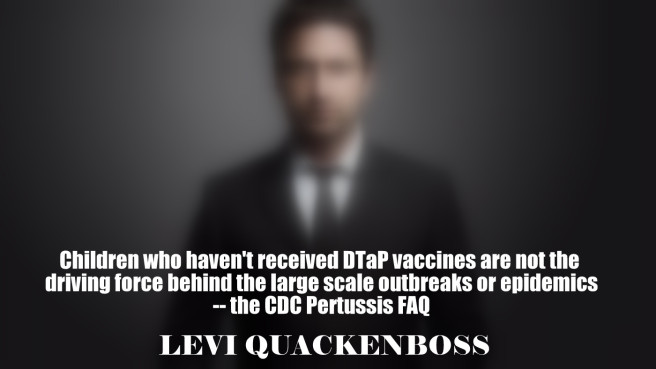
You Can’t Protect Another Person from Pertussis

Every year over 600 children under the age of 13 die in car accidents. That’s a terrible fact. But what would you say if your doctor, your child’s doctor, your state senators and everyone in the media told you that they had the solution to prevent these deaths? And it was totally, completely within your power to save them, and of course you’re a raging a-hole if you don’t follow this advice and save 600 children’s lives each year.
Are you ready for this genius idea?
Buckle your own seat belt.
Wait, what? Don’t I mean buckle the child’s seat belt? No. Buckle your own seat belt to save 600 children’s lives each year.
Makes zero sense, right? You buckling your own seat belt would have absolutely no impact on the number of accidents or the children who die in accidents each year in this country. At best, buckling your seat belt means that you are less injured in an accident than you’d be without it.
And yet we’re told that the answer to preventing the 10 infant deaths from whooping cough that happen each year in this country is to vaccinate ourselves, and our own older children, with the Tdap and DTaP. This is just as irrational as buckling yourself in to save someone else’s life.
{Bear with me through these next two paragraphs, they’re key. You might want to chew on them twice.}
Here’s why: the pertussis vaccines do not contain pertussis bacteria. The Tdap and DTaP vaccines that were phased in during the 1990s don’t confer immunity to pertussis bacteria. The vaccines contain pertussis toxoid. Toxoid is the inactivated version of the nasty exotoxin that the bacteria secrete during an infection that causes major damage to the human body. These “acellular” (meaning not whole cell) vaccines also contain pertactin, fimbria, and filamentous hemagglutinin– all of the gook that pertussis produces –in a failed attempt to stop pertussis from sticking to itself and posting up in your throat. Pertussis and pertussis toxin are not the same thing— think of it like the difference between grapes and wine. Do you get arrested for driving after eating grapes? No, you don’t. Because although one is made from the other, they’re not the same thing.
The pertussis toxin is called an AB toxin because the B-unit (B is for binding) binds to your healthy cells while the A-unit enters through the membranes and wreaks havoc. It’s the B-unit that the body can learn to recognize and get some immunity to. The DTaP/Tdap vaccines are for teaching your body to fight when it encounters the B-units.
Phew. The hard part is over. You made it. It’s all downhill from here.
But the key fact misrepresented by the media, lawmakers and medical establishment is this: the vaccines can’t fight pertussis until your body is infected and by then it’s too late to stop you from being contagious. There is no toxin to fight off–and no B-unit to recognize– until the infection takes hold anywhere from 4 to 21 days after exposure. DTaP and Tdap may be symptom-reducing vaccines, but they aren’t designed to prevent an infection from happening. They are not transmission-reducing vaccines. In fact, the pertussis toxin antibodies are of no use until an infection happens.
Are you going to encounter some B-unit pertussis toxin sludge out in your everyday life? Only if you work in a laboratory. And there’s no longer a vaccine in the states for regular whole cell pertussis bacteria that hasn’t produced any exotoxin.
The old DTP vaccine from the 50s, 60s, 70s and 80s (and was phased out 1996-1999) was probably somewhat responsible for the lower rate of diagnosed cases, but even in the late 90s researchers knew that kids vaccinated with DTP were developing pertussis infections without showing it. Between being vaccinated with the DTaP, DTP or enduring a natural infection, only those who have had a natural infection have true immunity from spreading contagious infections for up to 20 years.
The old whole cell DTP wasn’t preventing these 10 pertussis deaths per year either. In the three years spanning 1992 to 1994 when DTP was in use there were 32 total deaths (you do the math), 25 of them in infants under 6 months old. In 2014 there were 9 deaths under 11 months old. Granted, there have been medical advancements in the last 20 years that are saving infant lives if they’re infected with pertussis.
So by virtue of design, the DTaP and Tdap vaccines only work after you’re already well infected with pertussis, and the hope is that they keep you from getting as sick as you would without them. Sometimes it works, and sometimes– as you’ve read in the media— it completely fails. Maybe you get full-blown sick, maybe you feel like you have a bad cold, or maybe you don’t feel like you’re sick at all, but you’ve still got the infection. And you’ll still pass it along to a newborn baby.
But the DTaP and Tdap don’t impact the chances of you acquiring pertussis in the first place. They’re just your own personal seat belt in the event of an accident. There is nothing altruistic about vaccinating yourself with acellular pertussis. You’re not contributing to any “community immunity” by getting vaccinated. There is no such thing as “cocooning” a newborn baby with vaccinated family members.
The FDA and the CDC know this which is why you’ve NEVER* seen them blame the unvaccinated for the spikes in pertussis we’ve been seeing since 2004. It would be slanderous of them to make such an accusation because the United States effectively quit vaccinating for actual pertussis bacteria in the 90s. The DTaP and Tdap aren’t “weaker” bacterial vaccines. They’re not bacterial vaccines at all.
They are… say it with me now… bacterial toxoid vaccines.
And pregnant mothers who get the Tdap are not passing pertussis antibodies on to their babies. They’re more likely (though not guaranteed) to pass on pertussis toxin antibodies to the baby, but the amount of vaccine antibodies these Tdap babies are born with (the measurement tends to be 68 per milliliter) isn’t in the ballpark of what’s needed to prevent a raging pertussis infection in the event they’re exposed to the bacteria (which needs to be at least 256 per milliliter) and they drop rapidly after birth (to 20 per milliliter). What’s next? Telling mothers to get four doses of Tdap while pregnant?
Even if the prenatal vaccine sounds like it’s better than nothing, stop and consider the ingredients of the Tdap before making that choice.
After birth, that infant has the same chance of contracting pertussis in infancy as it did without the mother’s Tdap because it doesn’t have any pertussis antibodies. Well, almost the same chance, because if that baby is exposed to one of the newer strains of pertussis that doesn’t contain the pertactin component I mentioned earlier, not only is the prenatal Tdap not going to protect the child, but it almost acts like a lightening rod for the newer pertussis strains to cause infection.
You got it? Vaccinating yourself for the B-unit of the pertussis toxin is not going to stop you from picking up the pertussis bacteria. It’s not going to stop the pertussis from developing into an infection. It is not going to stop you from spreading pertussis. And it’s not going to protect an infant in your home or community from contracting pertussis– that would be like buckling your own seat belt to protect your neighbor’s new baby in a car accident.
________________________
* Here’s a Q&A with the CDC where they say that unvaccinated children are not the driving force behind outbreaks or epidemics:

(The unvaccinated aren’t really 8 times more likely to “get” pertussis because obviously they would then be the driving force. In fact, you just learned that the vaccinated are lightning rods for new pertussis strains. I emailed the CDC for the source on their statement and they responded with this study. It found that proportion of unvaccinated children was 7.8% of their studied pertussis cases and 92.2% were vaccinated. The only proper mathematical conclusion to draw from that finding is that one is 11.8 times more likely to be vaccinated if they have pertussis. — LQ)

For the hyperlink impaired:
http://www.cdc.gov/mmwr/preview/mmwrhtml/00048610.htm
http://www.cdc.gov/pertussis/clinical/disease-specifics.html
https://en.wikipedia.org/wiki/Exotoxin
http://wwwnc.cdc.gov/eid/article/6/5/00-0512_article
http://www.ncbi.nlm.nih.gov/pubmed/24277828
http://www.ncbi.nlm.nih.gov/pubmed/15876927
http://www.cdc.gov/mmwr/preview/mmwrhtml/00038200.htm
http://www.cdc.gov/pertussis/downloads/pertuss-surv-report-2014.pdf
http://www.fda.gov/newsevents/newsroom/pressannouncements/ucm376937.htm
http://www.cdc.gov/pertussis/about/faqs.html
http://jama.jamanetwork.com/article.aspx?articleid=1866102
http://jid.oxfordjournals.org/content/181/3/1010.full.pdf
http://www.cdc.gov/pertussis/pertactin-neg-strain.html
http://jama.jamanetwork.com/article.aspx?articleid=1456072